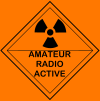Simulated Emergency Test (SET) Scheduled for October 5—6
The first weekend of October is when ARRL encourages local groups to hold the Simulated Emergency Test, or SET. Throughout September, ARRL shared materials about resilience through National Preparedness Month. Now, as entire areas are washed away in the aftermath of Hurricane Helene, the utility value of amateur radio is more necessary and visible than ever. When disaster strikes, infrastructur...
An Incredible Amateur Radio Rescue Story
Editor’s note: The following story was submitted by Don Gardner, W7PJ, ARRL Idaho Section Emergency Coordinator.
On the evening of September 21, 2024, Greg Owen, WX7Z, heard an amateur radio emergency call on the VHF frequency known as the national simplex calling frequency, 146.52 MHz. Ed Clark, K7ELC, was calling to get medical help for a 51-year-old man who had rolled his four-wheeler. Mac M...
Using a SDR as a RFI Site Survey Tool
This article explains how software-defined radios (SDRs) are used to detect and visualize radio ... - Listed in Technical Reference/Radio Frequency Interference
Going Full-Circle with a Kenwood TS-520S
This article is either a nostalgic yet technical look on restoring this popular ham ... - Listed in Radio Equipment/HF Transceivers/Kenwood TS-520S
VK9CV Cocos Keeling DXpedition
IOTA: OC-003 activation planned for November 01 – November 15, 2024
Operation modes: ... - Listed in DX Resources/DX Peditions/2024 DXpeditions
Coil64 Inductance Coil Calculator
Coil64 (Coil32) is a versatile tool for calculating single-layer inductance coils used in various ... - Listed in Software/RF Design
Candidate for ARRL Northwestern Division Director Disqualified; Tharp Declared Elected
Dan Marler, K7REX, the challenger seeking the position of ARRL Northwestern Division Director, was declared disqualified Saturday by the ARRL Ethics and Elections Committee (E&E). Marler was running against incumbent Mark Tharp, KB7HDX. Due to the disqualification, the committee has declared Tharp elected.
ARRL’s election rules state, “All matters concerning campaigns, including remedies for iss...
Current consumption for various HF Rigs
In this article, the current consumption for a selection of popular HF transceiver ... - Listed in Operating Modes/Portable Operations
URC DX RTTY Contest
We are excited to share the news about the inaugural URC DX RTTY Contest, ... - Listed in DX Resources/Contest/Contest Rules/RTTY
Icom IC-7760 Review: First Impressions by Difona Communication and WIMO
Two product reviews from Difona Communications and WIMO about the ICOM IC-7760
Top Amateur Radio Websites - Issue 2438
Affordable DIY AZ/EL Antenna Rotator: A Practical Guide, Ground Wave Propagation, Enhancements in UV-K5 HF Fullband Reception, Gnuradio Miniature Projects, Beam Controller Project, How to Renew Your US Ham Radio License, Beacons Remote Control, BlueMax49ers, Papa whiskey club
Tri-band Yagi Antenna for 20 17 15 meter band
A cost-effective alternative to the Optibeam OB10-3W, a high-performance but expensive tri-band Yagi antenna ... - Listed in Antennas/Yagi
ARRL Audio News September 27, 2024
ARRL Audio News September 27, 2024
National Preparedness Month - Get Involved
All September, the ARRL® Amateur Radio Emergency Service® (ARES®) has been promoting readiness and resilience for National Preparedness Month. As we come to the end of the month, a hurricane is churning in the Gulf of Mexico, with forecasts of up to 20 feet of storm surge expected to impact large portions of Florida. This underscores the need to be prepared. Even experienced hams and those who h...
Changes in the ARRL West Texas Section
Dale Durham, W5WI, has announced that he is retiring from the position of Section Manager of the ARRL West Texas Section. Dale has served in this role since July 1st, 2017. He has also served as the Section Emergency Coordinator, a Field Instructor, and as an Official Observer. David Overton, W5JDO, has been appointed to fill the remainder of the current term which will end on June 30th, 2025. D...
Amateur Radio and Robot Play Ball!
The Staten Island Technical High School Robotics Team, in Staten Island, New York, took its knowledge and skills to the baseball diamond. The team created a robot that was capable of throwing a ceremonial first pitch and, in early September, the members were invited to showcase and execute their robot at a Staten Island FerryHawks minor league game. But Everton Henriques, KD2ZZT, engineering an...
Volunteers – The Heart and Soul of ARRL Headquarters
The W3HH T2FD Antenna Project
This project describes the construction of a W3HH (T2FD) antenna for HF bands (3-30 ... - Listed in Antennas/T2FD
T2FD Calculator
An Excel sheet calculator for the T2FD wire antenna.
The sheet has been proved to ... - Listed in Antennas/Antenna Calculators
Helene - Storm Updates
Amateur radio continues to respond to two different tropical events as of Wednesday, September 25, 2024, at 12:00 PM Eastern, now Hurricane Helene and Tropical Depression John The National Hurricane Center reports that Tropical Storm Helene has been upgraded to a Category 1 Hurricane with 80 mph winds and is forecast to keep rapidly intensifying into a Category 3 hurricane by the time it makes ...
HVA1 All Band Vertical Antenna
Vertical antenna tests at the Sonten-Rancabali tea resort in Ciwidey, West Java. The assembly, ... - Listed in Antennas/Vertical
Helena - Storm Updates
Amateur radio is responding to two different tropical events as of Tuesday, September 24, 2024 at 1:00 PM Eastern.
Hurricane John The National Hurricane Center reports that Hurricane John made landfall on Mexico's southern Pacific coast late Monday evening about 80 miles east of the resort of Acapulco as a Category 3 storm. Winds were reported up to 120 miles per hour (mph) before the storm began...
7 Element VHF High Gainer
The 2m 7 element Yagi antenna is a perfect beam antenna with 11dB gain ... - Listed in Antennas/2M
Introduction to Digital Voice
Ham radio communication in the VHF and UHF bands, which was previously dominated by ... - Listed in Operating Modes/Digital Voice
Understanding Solar Activity and Its Impact on HF Propagation
The document discusses the classifications of sunspots and their potential for solar flare activity, ... - Listed in Propagation/Sunspots
Top Amateur Radio Websites - Issue 2437
Constructing a Lindenblad Antenna for Receiving Weather Satellite Signals, Buying an HF High Power Amplifier, NDBs Received Worldwide, Station QRP Handcrafted tube transmitters, Obtaining a Copy of Your FCC License, PRFCalc, Central Kansas Armature Radio Club,
External CatDisplay for the YAESU FT817
The article explains how to adapt the YAESU FT817 transceiver so that it can ... - Listed in Radio Equipment/HF Transceivers/Yaesu FT-817
ARRL Audio News September 20, 2024
ARRL Audio News September 20, 2024
National Preparedness Month - Station Readiness
As ARRL continues the September series on National Preparedness Month, we turn to a critical element for radio amateurs and especially Amateur Radio Emergency Service® (ARES®) volunteers: their station. Many hams have a home station from which we operate on a regular basis. Is your station set up to operate or have the ability to operate off the grid or on alternate power sources? There are m...
ARRL Section Managers Gather for Training at Headquarters
The ARRL Field Organization is divided geographically into 71 sections. A key volunteer that members in each section elect is the Section Manager. These ARRL member-volunteers take a critical role in being the front line of the organization to members. On Saturday, September 15, 2024, 13 ARRL Section Managers gathered at ARRL Headquarters in Newington, Connecticut, for training. ARRL staff memb...
Yaesu FF-501DX Low Pass Filter
The FF-501DX LPF, a high-performance VHF and 10m filter, was obtained at a friend's ... - Listed in Technical Reference/Filters
ICOM Responds to Reports of Exploding Radios in Lebanon
Icom addressed reports of its V-82 radios being involved in Lebanon explosions, suggesting counterfeit or discontinued models with modified batteries. The company emphasized strict distribution controls and Japanese manufacturing standards.
ARRL Philanthropist, Radar Detector Pioneer, Michael Valentine, W8MM, Silent Key
Michael “Mike” D. Valentine, W8MM, of Cincinnati, Ohio, passed away on Monday, September 16, 2024. He was 74. Mike and his wife of 51 years, Margaret “Peg” K. Valentine, have been the most generous individual supporters of ARRL The National Association of Amateur Radio. Valentine earned his amateur radio license as a teenager. “I was first licensed as WN8MSF and WA8MSF, simultaneously in the sp...
ARRL Announces Partnership with Grouper
Optimizing Vertical Antennas: Understanding Radiation Angles
This article focus on the radiation angle of vertical antennas and the fundamentals ... - Listed in Antennas/Theory
|









